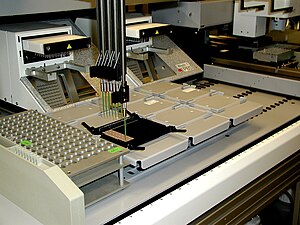Proteomika

Proteomika je izučavanje proteina velikih razmera sa fokusom na njihovu strukturu i funkcije.[1][2] Proteini su vitalni delovi živih organizama. Oni su glavne komponente fizioloških metaboličkih puteva u ćelijama. Termin proteomika je formiran 1997[3] po analogiji sa genomikom, studijom genoma. Reč proteom je mešavina reči protein i genom, koju je formirao Mark Vilkins 1994.[4][5]
Proteom je celokupan set proteina[4] koji jedan organizam proizvodi ili modifikuje. Njegov sadržaj varira s vremenom i u zavisnosti od raznih uslova, stresova, kojima su ćelija ili ogranizam izloženi. Proteomika je interdisciplinarni domen koji je znatnim delom formiran na bazi istraživanja i razvoja Projekta ljudskog genoma. Ona obuhvata naučna istraživanja i ispitivanja proteoma sa sveobuhvatnog stanovišta intracelularne proteinske kompozicije, strukture, i njegovih jedinstvenih parterna dejstva. Proteomioka je važna komponenta funkcionalne genomike.
Mada se termin proteomika generalno odnosi na eksperimentalnu analizu proteina velikih razmera, on se isto tako koristi za proteinsko prečišćavanje i masenu spektrometriju.
Reference
- ↑ Anderson NL, Anderson NG (1998). „Proteome and proteomics: new technologies, new concepts, and new words”. Electrophoresis 19 (11): 1853–61. DOI:10.1002/elps.1150191103. PMID 9740045.
- ↑ Blackstock WP, Weir MP (1999). „Proteomics: quantitative and physical mapping of cellular proteins”. Trends Biotechnol. 17 (3): 121–7. DOI:10.1016/S0167-7799(98)01245-1. PMID 10189717.
- ↑ P. James (1997). „Protein identification in the post-genome era: the rapid rise of proteomics.”. Quarterly reviews of biophysics 30 (4): 279–331. DOI:10.1017/S0033583597003399. PMID 9634650.
- ↑ 4,0 4,1 Marc R. Wilkins, Christian Pasquali, Ron D. Appel, Keli Ou, Olivier Golaz, Jean-Charles Sanchez, Jun X. Yan, Andrew. A. Gooley, Graham Hughes, Ian Humphery-Smith, Keith L. Williams & Denis F. Hochstrasser (1996). „From Proteins to Proteomes: Large Scale Protein Identification by Two-Dimensional Electrophoresis and Arnino Acid Analysis”. Nature Biotechnology 14 (1): 61–65. DOI:10.1038/nbt0196-61. PMID 9636313.
- ↑ „UNSW Staff Bio: Professor Marc Wilkins”. Arhivirano iz originala na datum 2009-02-12. Pristupljeno 2014-03-17.
Literatura
- Belhajjame, K. et al. Proteome Data Integration: Characteristics and Challenges Arhivirano 2006-06-28 na Wayback Machine-u. Proceedings of the UK e-Science All Hands Meeting, ISBN 1-904425-53-4, September 2005, Nottingham, UK.
- Twyman RM (2004). Principles Of Proteomics (Advanced Text Series). Oxford, UK: BIOS Scientific Publishers. ISBN 1-85996-273-4. (covers almost all branches of proteomics)
- (focused on 2D-gels, good on detail)
- Liebler DC (2002). Introduction to proteomics: tools for the new biology. Totowa, NJ: Humana Press. ISBN 0-89603-992-7. ISBN 0-585-41879-9 (electronic, on Netlibrary?), ISBN 0-89603-991-9 hbk
- Wilkins MR, Williams KL, Appel RD, Hochstrasser DF (1997). Proteome Research: New Frontiers in Functional Genomics (Principles and Practice). Berlin: Springer. ISBN 3-540-62753-7.
- Arora PS, Yamagiwa H, Srivastava A, Bolander ME, Sarkar G (2005). „Comparative evaluation of two two-dimensional gel electrophoresis image analysis software applications using synovial fluids from patients with joint disease”. J Orthop Sci 10 (2): 160–6. DOI:10.1007/s00776-004-0878-0. PMID 15815863. [mrtav link]
- Rediscovering Biology Online Textbook. Unit 2 Proteins and Proteomics. 1997–2006.
- Weaver RF (2005). Molecular biology (3rd izd.). New York: McGraw-Hill. str. 840–9. ISBN 0-07-284611-9.
- Reece J, Campbell N (2002). Biology (6th izd.). San Francisco: Benjamin Cummings. str. 392–3. ISBN 0-8053-6624-5.
- Hye A, S, Lynham, M, Thambisetty i dr.. (November 2006). „Proteome-based plasma biomarkers for Alzheimer's disease”. Brain 129 (Pt 11): 3042–50. DOI:10.1093/brain/awl279. PMID 17071923.
- Perroud B, J, Lee, N, Valkova i dr.. (2006). „Pathway analysis of kidney cancer using proteomics and metabolic profiling”. Mol Cancer 5: 64. DOI:10.1186/1476-4598-5-64. PMC 1665458. PMID 17123452.
- Yohannes E, Chang J, Christ GJ, Davies KP, Chance MR (July 2008). „Proteomics analysis identifies molecular targets related to diabetes mellitus-associated bladder dysfunction”. Mol. Cell Proteomics 7 (7): 1270–85. DOI:10.1074/mcp.M700563-MCP200. PMC 2493381. PMID 18337374. .
- Macaulay IC, Carr P, Gusnanto A, Ouwehand WH, Fitzgerald D, Watkins NA (December 2005). „Platelet genomics and proteomics in human health and disease”. J Clin Invest. 115 (12): 3370–7. DOI:10.1172/JCI26885. PMC 1297260. PMID 16322782.
- Rogers MA, P, Clarke, J, Noble i dr.. (2003-10-15). „Proteomic profiling of urinary proteins in renal cancer by surface enhanced laser desorption ionization and neural-network analysis: identification of key issues affecting potential clinical utility”. Cancer Res. 63 (20): 6971–83. PMID 14583499.
- Vasan RS (May 2006). „Biomarkers of cardiovascular disease: molecular basis and practical considerations”. Circulation 113 (19): 2335–62. DOI:10.1161/CIRCULATIONAHA.104.482570. PMID 16702488.
- "Myocardial Infarction" Arhivirano 2006-12-06 na Wayback Machine-u. (Retrieved 29 November 2006)
- Introduction to Antibodies – Enzyme-Linked Immunosorbent Assay (ELISA). (Retrieved 29 November 2006)
- Decramer S, S, Wittke, H, Mischak i dr.. (April 2006). „Predicting the clinical outcome of congenital unilateral ureteropelvic junction obstruction in newborn by urinary proteome analysis”. Nat Med. 12 (4): 398–400. DOI:10.1038/nm1384. PMID 16550189.
- Mayer U (January 2008). „Protein Information Crawler (PIC): extensive spidering of multiple protein information resources for large protein sets”. Proteomics 8 (1): 42–4. DOI:10.1002/pmic.200700865. PMID 18095364.
- Jörg von Hagen, VCH-Wiley 2008 Proteomics Sample Preparation. ISBN 978-3-527-31796-7
Vidi još
- Bioinformatika
- Citomika
- Genomika
- Lipidomika
Spoljašnje veze
 | Portal Informatika |
 | Portal Biologija |
 | Portal Medicina |
- Proteomics na Projektu Open Directory






